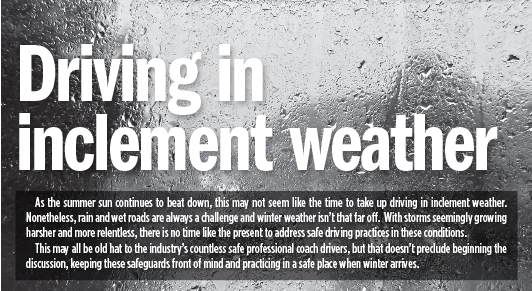
Pre-trip prep
If conditions look bad, get off the road.
Anticipate a change in weather. Check a weather report before departure and always be prepared for sudden changes in road conditions. In threatening weather, the pre-trip inspection should include attention to tires, tire chains (if needed) and wiper blades.
Don’t go.
When the weather turns severe with heavy storms in the forecast, avoid making the trip. Postpone or cancel if possible. If the conditions look particularly ominous, stay off the roads until they clear.
On the road
Drive at a slower speed.
Most accidents in inclement weather occur simply because the coach is traveling too fast for road conditions. Driving at reduced speed allows more reaction time in an event.
Turn off the Cruise Control.
The driver has more options without cruise control. In rain and snow, cruise control only increases the chance of losing control. To maintain traction, the driver needs to let off the accelerator quickly to reduce speed and maintain traction.
Leave room.
In inclement weather, allow ample stopping distance between vehicles on the road by increasing the following distance from the vehicle in front. Allow at least three times the usual distance.
Get a grip.
Hold the steering wheel firmly and keep the vehicle steady through snow, ice and heavy wind. Avoid quick moves and sharp turns. Where possible, drive in the tracks of the vehicle ahead.
Brake and accelerate lightly.
Try not to do anything forcefully in slippery road conditions. Lightly pump the brakes to reduce the chance of locking the tires and going into a skid.
To engage the anti-lock braking system (ABS) in an emergency, press and hold the brake down as far as possible. The ABS prevents the wheels from locking, enabling the driver to steer.
Skids happen.
The coach can go into a skid at any time for any reason. Don’t panic during a skid – let the training take over. As the coach begins to skid, the driver must avoid hard braking, turning sharply, and continue to steer in the direction the front of the coach should go. Brake, turn and accelerate one step at a time.
Beware of black ice.
Black ice is a thin layer of transparent ice formed when the temperature is close to freezing, with the road appearing to be wet rather than frozen. Black ice is the most dangerous winter road condition. It’s difficult to spot when the temperature gets close to freezing. Look for clues. Watch other vehicles, feel the road, and get off the road at the earliest possible moment. Anticipate bridges, structures and highway overpasses being more slippery than the pavement, which typically freeze first.
More information on Prevost Prep can be found at www.uma.org/academy.

